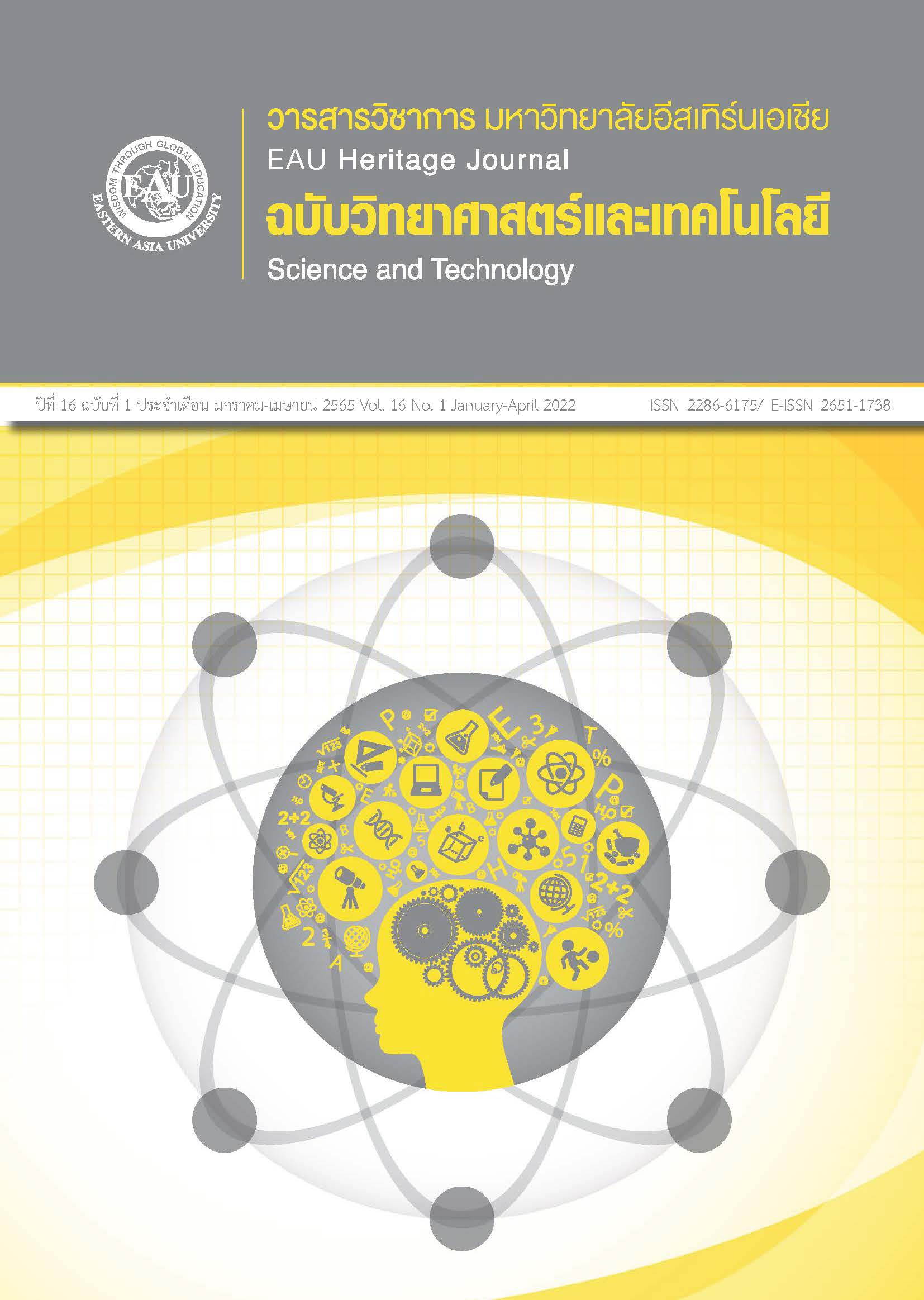การประยุกต์ใช้ข้อมูลระยะเอื้อมในการปรับปรุงสถานีงานบรรจุหมี่โคราช
คำสำคัญ:
การยศาสตร์, สถานีงาน, ระยะเอื้อมบทคัดย่อ
การวิจัยครั้งนี้เป็นการวิจัยเชิงสำรวจและทดลอง วัตถุประสงค์เพื่อศึกษาความไม่สบายตามบริเวณส่วนต่าง ๆ ของร่างกายที่เกิดจากการทำงานผลิตหมี่โคราชและปรับปรุงสถานีงานโดยใช้ข้อมูลระยะเอื้อมและเปลี่ยนตำแหน่งการจัดวางอุปกรณ์เพื่อลดการบาดเจ็บจากการทำงาน ผู้ถูกทดสอบคือพนักงานในกลุ่มผู้ผลิตสินค้าชุมชนแห่งหนึ่งจำนวน 10 คนซึ่งเป็นเพศหญิงทั้งหมด งานวิจัยนี้รวบรวมข้อมูลความปวดเมื่อยของร่างกายโดยใช้แบบประเมินความเสี่ยงอาการผิดปกติของระบบโครงร่างกระดูกและกล้ามเนื้อจากการทำงาน การวัดระยะเอื้อมมี 3 ระยะ คือ ระยะเอื้อมปกติ ระยะเอื้อมมากที่สุด และระยะเอื้อมแบบโน้มลำตัว โดยมีมุมของแขน 0 องศาถึง 120 องศา รวมถึงการศึกษาเวลาที่ใช้ในการทำงาน จากนั้นจึงดำเนินการปรับปรุงสถานีงานและปรับเปลี่ยนขั้นตอนการทำงาน ผลการวิจัยพบว่าระยะเอื้อมปกติมีค่ามากที่สุดที่มุม 30 องศา ระยะเอื้อมมากที่สุดมีค่ามากที่สุดที่มุม 60 องศา ระยะเอื้อมแบบโน้มลำตัวมีค่ามากที่สุดที่มุม 90 องศา ผลจากแบบประเมินความเสี่ยงอาการผิดปกติพบว่าพนักงานเคยมีอาการบาดเจ็บหรือไม่สบายบริเวณหลังส่วนล่างมากที่สุด รองลงมา คือ บริเวณหัวเข่า ข้อมือ แขนส่วนบน แขนส่วนล่าง และไหล่ตามลำดับ หลังการปรับปรุงสถานีงานพบว่าอาการปวดเมื่อยตามส่วนต่าง ๆ ของร่างกายหลังปฏิบัติงานลดลง การกำจัดการเคลื่อนไหวที่ไม่จำเป็นและลดขั้นตอนการทำงานที่ซ้ำซ้อน ลดเวลาในการบรรจุหมี่จำนวน 150 ถุง จาก 2 ชั่วโมง 42 นาที เหลือ 1 ชั่วโมง 20 นาที
เอกสารอ้างอิง
Bazazan, A., Dianat, I., Feizollahi, N., Mombeini, Z., Shirazi, A. M., & Castellucci, H. I. (2019). Effect of a posture correction-based intervention on musculoskeletal symptoms and fatigue among control room operators. Applied Ergonomics, 76, 12-19. doi: 10.1016/j.apergo.2018.11.008
Chengalur, S. N., Rodgers, S. H., & Bernard, T. E. (2004). Kodak’s ergonomic design for people at work (2nd ed). Rochester, N.Y.: Eastman Kodak Company.
Choobineh, A., Hosseini, M., Lahmi, M., Khani Jazani, R., & Shahnavaz, H. (2007). Musculoskeletal problems in Iranian hand-woven carpet industry: Guidelines for workstation design. Applied Ergonomics, 38(5), 617–624. doi: 10.1016/j.apergo.2006.06.005
Choobineh, A., Tosian, R., Alhamdi, Z., & Davarzanie, M. (2004). Ergonomic intervention in carpet mending operation. Applied Ergonomics, 35(5), 493–496. doi: 10.1016/j.apergo.2004.01.008
Das, B., & Black, N. L. (2000). Isometric pull and push strengths of paraplegics in the workspace: 1. Strength measurement profiles. International Journal of Occupational Safety and Ergonomics: JOSE, 6(1), 47–65. doi: 10.1080/10803548.2000.11076443
Dianat, I., Kord, M., Yahyazade, P., Karimi, M. A., & Stedmon, A. W. (2015). Association of individual and work-related risk factors with musculoskeletal symptoms among Iranian sewing machine operators. Applied Ergonomics, 51, 180–188. doi: 10.1016/j.apergo.2015.04.017
Domingo, J. R. T., Pano, Ma. T. S. D., Ecat, D. A. G., Sanchez, N. A. D. G., & Custodio B. P. (2015). Risk assessment on filipino construction workers. Procedia Manufacturing, 3(2015), 1854–1860. doi: 10.1016/j.promfg.2015.07.226
Freivalds, A., & Niebel, B. (2014). Niebel’s methods, standards and work design. N.Y.: McGraw-Hill Education.
Garosi, E., Mazloumi, A., Kalantari, R., Vahedi, Z., & Shirzhiyan, Z. (2019). Design and ergonomic assessment of an infusion set connector tool used in nursing work. Applied Ergonomics, 75, 91–98. doi: 10.1016/j.apergo.2018.09.008
Kanokwan, S., Intu-on, H., Ariya, K., & Nattawut, L. (2018). Wastes reduction in Vien-Hua Candle production process case study: Tien Mong Khon Casting Factory. UBU Engineering Journal, 12(2), 112-122. (in Thai)
Klorklear, W., Panjit, S., & Waranyoo, T. (2016). Efficiency improvement of the pottery production process to reduce waste and increase the production quality: Case study of Huaywangnong Pottery Group Ubonratchathani. UBU Engineering Journal, 9(2), 38-46. (in Thai)
Konz, S., & Goel, S. C. (2007). The shape of the normal work area in the horizontal plane. A I I E Transactions, 1(1), 70-74. doi: 10.1080/05695556908974416
Kuorinka, I., Jonsson, B., Kilbom, A., Vinterberg, H., Biering-Sørensen, F., Andersson, G., & Jørgensen, K. (1987). Standardised Nordic questionnaires for the analysis of musculoskeletal symptoms. Applied Ergonomics, 18(3), 233–237. doi: 10.1016/0003-6870(87)90010-x
Kushwaha, D. K., & Kane, P. V. (2015). Ergonomic assessment and workstation design of shipping crane cabin in steel industry. International Journal of Industrial Ergonomics, 52(2016), 29-39. doi: 10.1016/j.ergon.2015.08.003
Loo, H. S., & Yeow, P. H. (2015). Effects of two ergonomic improvements in brazing coils of air-handler units. Applied Ergonomics, 51, 383–391. doi: 10.1016/j.apergo.2015.06.007
McDonald, A. C., Mulla, D. M., & Keir, P. J. (2019). Muscular and kinematic adaptations to fatiguing repetitive upper extremity work. Applied Ergonomics, 75, 250–256. doi: 10.1016/j.apergo.2018.11.001
Robertson, M., Amick, B. C., DeRango, K., Rooney, T., Bazzani, L., Harrist, R., & Moore, A. (2009). The effects of an office ergonomics training and chair intervention on worker knowledge, behavior and musculoskeletal risk. Applied Ergonomics, 40(1), 124–135. doi: 10.1016/j.apergo.2007.12.009
Sanders, M. S., & McCormick E. J. (1993). Human factors in engineering and design (7th ed), N.Y.: McGraw-Hill Education
Sengupta, A. K., & Das, B. (2000). Maximum reach envelope for the seated and standing male and female for industrial workstation design. Ergonomics, 43(9), 1390–1404. doi: 10.1080/001401300421824







